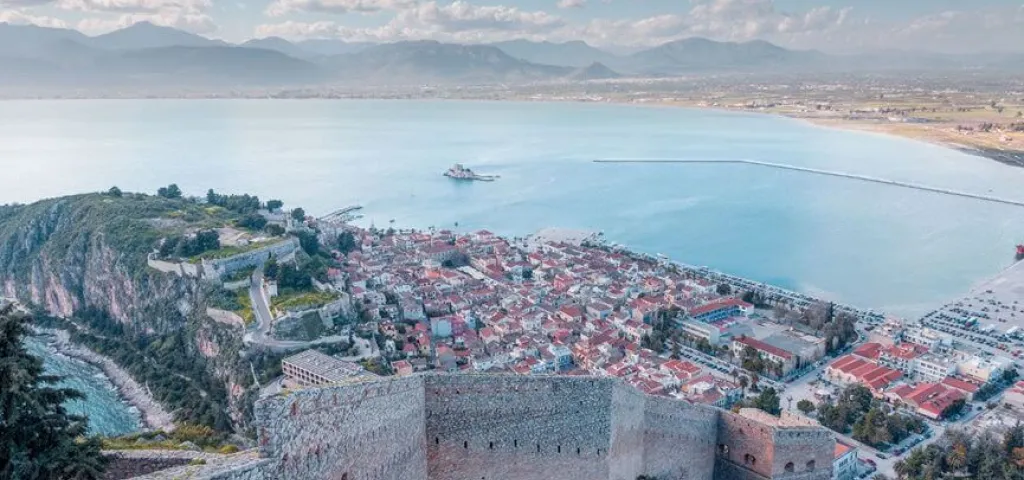
Nafplio is famous for its listed architecture and majestic Venetian castles. Best of all, it is just a short drive from Athens, perfect for a daytrip or a stopover during a road trip in the Peloponnese.
Nafplio is a city in the Peloponnese that brims with life, preserving its legends and enticing you into its mystical ambience. It was the Venetians’ ‘Naples of the East’ and the first capital of Greece.
Viewed from above, Nafplio oozes romance: tile roofs, grand homes and a blue-green sea. The famous Bourtzi, Akronafplia and Palamidi castles add a sense of drama to this stunning seaport town, consisting of fortresses, neoclassical buildings, old neighbourhoods, wide sidewalks and large squares.
What to do in Nafplio
Climb all 999 steps of Palamidi Castle
Are there 999 or 857 steps that lead to the top of Palamidi Castle? Discover for yourself. Once you climb up the steep hill, you’ll be rewarded with a panoramic view of Nafplio and the sea. The fortress was built in record time, between 1711 and 1714.
Admire the view from the Acropolis of Nafplio
The Acropolis of Nafplio, which the Turks named Its Kale, was erected by the Venetians and later passed on to the Byzantines and Ottomans. It has three levels, each with a different castle and walls from different time periods. From the rock of Akronafplia, you’ll take in the view from the Bourtzi Castle to Arvanitias beach.
Feel the historical vibes of Bourtzi Castle
From afar, Bourtzi Castle looks like an elegant stone sculpture. As you approach the islet of Agio Theodoro by boat, travelling the few metres that separate it from the coast and finally see the Venetian castle up close, you’ll immediately feel its rich and tumultuous history.
The castle (shaped like an irregular hexagon) was built in 1473 and the executioners of Palamidi prisoners once lived here. It was also the residence of two governments (of 1824 and 1827) and a luxury hotel. Today it is one of the most significant attractions in Nafplio, and hosts various cultural events and festivals.
Take a long stroll along the famous promenade
The walk along Arvanitia promenade, with its view of the Argolic Gulf, is Nafplio at its most romantic. You’ll begin at the waterfront and end up, after about 1km, at Arvanitias Square. The whole time, you’ll be walking beneath the rock of Akronafplio and you’ll also come across the pretty little chapel of Panagia tis Spilia (Virgin Mary of the Cave), the Santa Maria Grotta of the Venetians.
Admire the architecture of Nafplio’s neoclassical buildings
At the epicentre of the old town is Syntagma Square, surrounded by historic buildings – Trianon, the Archaeological Museum and the National Bank of Greece, built in the 1930s. On the nearby streets, you’ll witness the modern history of Greece starting with the Hellenic Parliament (Vouli ton Ellinon).
Further along, witness the church of Agios Spyridonas (outside of which Ioannis Capodistrias, Greece’s first prime minister, was murdered in 1831) and across from that, the only Turkish bath in town. Two other squares, Agios Georgios and Trion Navarhon, also have several interesting monuments and grand mansions worth seeing.
City Sights
Palamidi Fortress
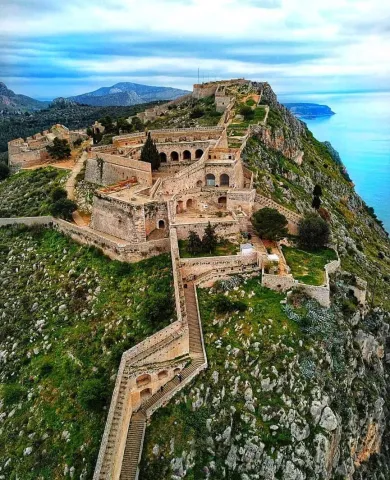
Palamidi is a fortress to the east of the Acronauplia in the town of Nafplio in the Peloponnese region of southern Greece.
Nestled on the crest of a 216-metre (709 ft) high hill, the fortress was built by the Venetians during their second occupation of the area (1686–1715).
The fortress was a very large and ambitious project, but was finished within a relatively short period from 1711 until 1714. It is a typical baroque fortress based on the plans of Venetian engineer Antonio Giancix (Antun Jančić) and built by French military engineer Pierre de la Salle.
In 1715 it was captured by the Ottomans and remained under their control until 1822, when it was captured by the Greeks.
The eight bastions of the fortress were originally named after the Venetian provveditori.
However, when it fell to the Ottoman Empire, the bastions were given Turkish names. Lastly, when the Greeks overthrew the Turks the bastions were renamed after ancient Greek leaders and heroes (Epaminondas, Miltiades, Leonidas, Phocion, Achilles, Themistocles. The two remaining bastions were named after St. Andrew (Agios Andreas) and the French Philhellene Robert who died in battle on the Acropolis of Athens. The "Miltiades," was used as a prison and among its walls was also held Theodoros Kolokotronis, hero of the Greek Revolution.
The fortress commands an impressive view over the Argolic Gulf, the city of Nafplio and the surrounding country. There are 913 steps in the winding stair from the town to the fortress. However, to reach the top of the fortress there are over one thousand. Locals in the town of Nafplio will say there are 999 steps to the top of the castle, and specials can be found on menus that incorporate this number to catch a tourist's eye.
Akronafplia Fortress
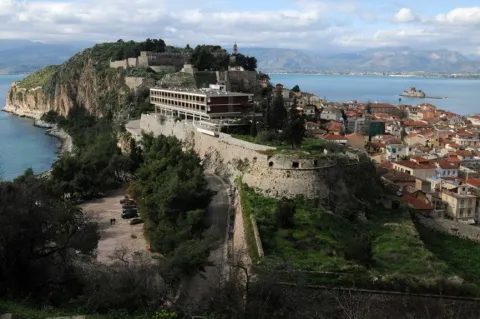
Akronafplia Fortress was originally a town in itself and is located in the ancient part of the city of Nafplio.
Formerly an ancient acropolis, it was first built in the 3rd century with walls that top 85 metres high.
Akronafplia was enhanced over the centuries and has influences from both the Venetians and the Franks. Interestingly, until about 80 years ago it was used as a prison by the Greek government but is now one of the top attractions in Nafplio.
Attracting many visitors each year, this impressive fortress has amazing views over the town and the sea. After a walk around the huge stone walls, you can pay a visit to the nearby Church of Our Lady of The Cave – Santa Maria Della Grotta.
Two other castles and several museums are also near to this stunning fortress, which is the oldest of the three.
The Nafplia Palace Hotel (not operated) now occupies part of the site. This is also one of the best places in Greece to view the sunset at the end of the day.
Bourtzi Fortress
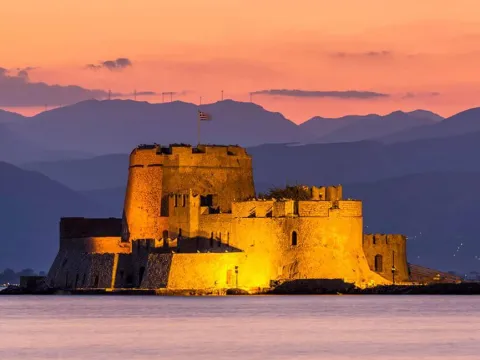
The most photographed spot of Nafplio –and its point of reference as well– is Bourtzi, the Venetian small fortress standing on the rocky islet of Agioi Theodoroi.
Antonio Gambello, an architect from Bergamo, built the castle in 1471 on this tiny islet in front of the port of Nafplion, although the construction was completed by the engineer Brancaleone. The design was made specifically to fit the narrow shape of the islet.
The entire city was fortified in 1473 by the Venetians, mainly to provide protection against pirates. The castle, with entrances to the north and south, has three floors connected by movable stairs.
During the Venetian rule it was connected to Akronafplia through a huge metal chain that secured the port against enemy ship attacks.
A small harbor on the north-eastern side offered easy and safe access to the fortress. To get protected by their enemies, the Turks had laid the surrounding sea bed with a large barricade of stones that made it impossible for large ships to approach the island and the fort.
At the beginning of 1860 in Bourtzi used to live the executioners of Palamidi prisoners.
Between 1930 and 1970, after alterations by the German architect Wolf Schaeffer, the Bourtzi Castle was used as a hotel. Today the island hosts the Summer Music Festival, providing a perfectly stunning backdrop to the gala of music.
It is easily accessible by boat from the port of Nafplio and it is a must for the visitors of this beautiful town.
In the summer you can reach the fortress by boat departing regularly from the port. If you are lucky enough you may even be able to attend one of the fascinating festivals taking place on the islet!
Old City
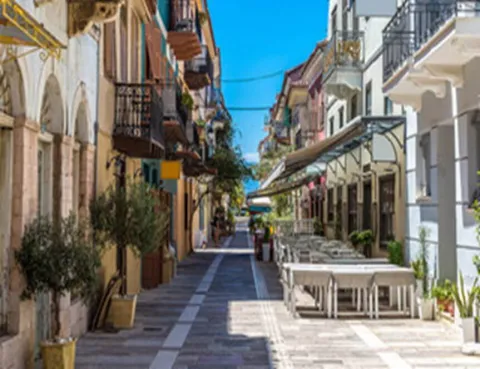
The Old Town stretches north of Akronaflia Castle, from the Old Railway Station to the Five Brothers bastion. The walk through its picturesque alleys is enchanting, since the visitor passes between squares and well-preserved neoclassical buildings, as well as picturesque taverns and shops. There, you will also meet the church of Agios Spyridon, where Ioannis Kapodistrias was murdered.
From the Old Town you can go across to Bourtzi, while the most romantic will be delighted with the walk in Arvanitia, as the historical site between the rock of Palamidi and the southern foothills of Akronaflia is called.
Vouleftiko, the first Parliament of the Greeks
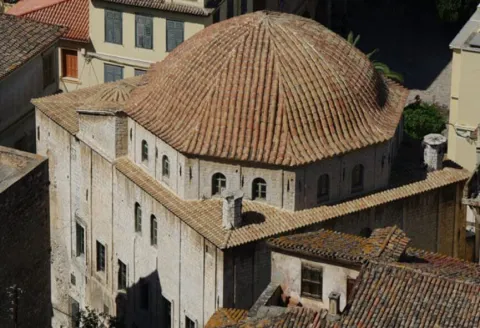
Strolling downtown Nafplio, in Syntagma Square, you will find an imposing mosque.
The well-kept building was built circa 1730, with a large hall and a massive dome typical of the late Ottoman architecture. From the autumn of 1825 until the spring of 1826 the mosque housed the first Hellenic Parliament.
According to local tradition, the mosque was built by the Ottoman Aga Pasha in an attempt to atone for a crime he had committed by killing two Venetian men who had come to Nafplio to discover the treasure their ancestor hid. With the treasure Aga Pasha discovered, he paid the erection of the mosque. He would not see it complete nonetheless, as he committed suicide jumping, full of remorse, from his balcony.
Vouleftiko has been used for a variety of purposes over time.
In 1831 the Hellenic School operated for a short time, while its ground floor served as a prison.
In 1834, during the Vice-royalty period, it took place the trial of two exemplary chieftains of the Greek Revolution, Theodoros Kolokotronis and Dimitrios Plapoutas.
Today, Vouleftiko has been restored by the Ministry of Culture and serves as a conference and cultural center.
The Municipal Art Gallery of Nafplio was recently moved to the ground floor of the building, with an exquisite collection of paintings by modern artists.
USEFUL INFORMATION
- USEFUL TELEPHONES
-
EMERGENCY CALL 112
FIRST AID 166
POLICE 100
FIRE DEPARTMENT 199
FOREST SERVICE 191
GENERAL HOSPITAL +30 27520 98100
NAFPLIO BUS STATION +30 27520 27323
NAFPLIO RAILWAY STATION +30 27520 26400
TOURIST INFORMATION OFFICE +30 27520 24444
RADIOTAXI NAFPLIO 18300
RADIO TAXI AGIOS CRHISTOFOROS +30 27520 24720 - NAFPLIO HOTELS
-
REX HOTEL +30 27520 26907
HOTEL KAPODISTRIAS +30 27520 99262
PARK HOTEL +30 27520 27428
AMALIA HOTEL +30 27520 24401
DIAS BOUTIQUE HOTEL +30 27520 22276
ASIMONI PENSION +30 27520 26088

